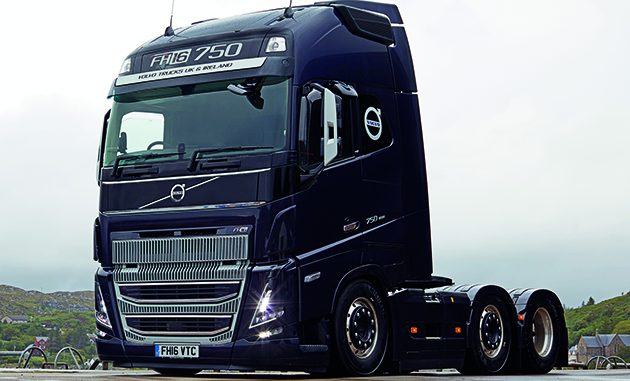
Last year Transport News assessed the outgoing ‘classic’ Volvo FH16 750, now the all-new version is put under the spotlight. Using the same driveline, changes to Volvo’s new generation are made in and around the cab, but are they an improvement?
MOST OF the truck manufacturers have worked on their product line-up in the past five years. Last year it was Volvo Trucks’ turn to unveil its latest incarnation at the heavier end of their offerings.
While FM and FMX got the most attention as the Swedes brought synergy to the range, subtle changes to FH and FH16 were largely overlooked.
As an iconic vehicle, few better the Volvo FH16 for style and substance. It is a towering behemoth that is often photographed pulling huge pieces of equipment for infrastructure projects, or low loaders with construction vehicles.
So, what are these subtle changes? There are three external trim levels on offer with incredibly technical names.
EXTL-BAS comes with a mix of Lightening Grey for the sun visor, wing mirror covers, front steps trim, bumpers, bumper spoiler and lower instep box, and Thunder Grey for the door handles, front lid grille and lower front panel. Chrome is used to surround headlights and indicators.
EXTL-EN3 uses silver for the sun visor, wing mirror covers, front lid grille and lower front panel; shiny chrome for the door handles and motifs, black around light clusters, with the operator’s choice of cab colour used for the bumpers, bumper spoiler and lower instep box.
And finally, EXTL-BAS with sturdy front (bumper). It’s the same as EXTL-EN3 for the most part save for the steel bumper painted grey and lower instep box, which is in Lightening Grey.
There is a mild external facelift with V-shaped headlights and indicators positioned outwards, which Volvo suggested improves aerodynamics. There is a slimmer windscreen wiper panel, and the iron mark has grown in size.
Overall, the cab has had its pointier edges smoothed with gaps between the upper and lower front cab sections made smaller to improve aerodynamics and efficiency.
This particular test, undertaken between Scottish coronavirus lockdowns, is with the 16.1 litre engine delivering a badged 750hp and 3,550Nm torque. It is the most powerful of the three options available; the other two are the entry level 550hp/2,800Nm engine that’ll go with a direct drive transmission that will cope with 60 tonnes gross combined weight (GCW) and the 650hp/3,150Nm version.
Technically, the 750 version produces 740hp from 1,600 to 1,800rpm and all that 3,550Nm peak torque, which provides all that sustained motion, starts at 950rpm and works along a flat band to 1,400rpm.
The drive axle is the RSS1370 single reduction, with a choice of three final drive ratios; 3.40, 3.67 and 4.11:1. There is plenty of choice for hub reduction should you require it.
At 9,150kg, the kerbweight is like for like with the outgoing model.
An operator can choose from five different cab sizes. Each have three steps, which measure 1,149mm from the top of the first step to the cab floor. All the cabs come with a 90mm engine tunnel height with internal height measured from the engine tunnel to the ceiling. Four cabs are 2,225mm long. Options include;
• Low Sleeper cab. It has 1,380mm standing room, 830mm headroom above the bunk, and the bunk is 2,000mm by 815mm, although it is narrower behind the seats.
• Sleeper cab. With 1,620mm standing room and 1,070mm headroom above the lower bunk, it is designed for two drivers if needs be, and the same lower bunk width measurements as the Low Sleeper, although the upper bunk is 100mm shorter in length.
• Globetrotter cab. It has 1,960mm standing room over the engine cover, headroom above the lower bunk is 675mm and 635mm above the upper bunk.
• Globetrotter XL. There is 2,110mm standing room over the engine tunnel and that extra height gives the one sleeping on the first floor 785mm of headroom.
• And the Globetrotter XXL tops the list. The same standing height as XL, the lower bunk is 2,130mm long and is 1,065mm at its widest point, and the upper bunk enjoys 785mm of headspace, plus it is the longest cab on offer at 2,475mm. All cabs have the same width of 2,495mm.
Should you order two bunks for any of the three Globetrotter cabs but only deploy one driver for that vehicle, ‘Drive’ can sleep on the first floor bunk and lower it by 135mm to create even more space upstairs.
There are two cab trims: FH16 trim comes with textile and leather upholstery, rubber mats, and decor trim; and FH16 leather trim has all-leather upholstery, rubber mats and decor trim.
For the chauffeur of freight there are three options; Drive, Drive16 and Drive16++. The latter is on this Globetrotter XL, which is for drivers who fly solo, because where the second bunk would usually be there are storage lockers.
Just a quick note to say that this wagon was put together before Volvo announced that new trucks would be fitted with Alexa, which is Amazon’s cloud-based voice service. So, there was no chance to say, ‘Alexa drive me to Perth’.
Setting off from Carlisle heading north on the M74 towards Glasgow we set the truck at 53mph to keep us out of the way of professionals. It climbed the first section of Beattock in top gear but was forced to concede a gear on the steeper second section, something it didn’t do last time (TN, May 2005).
Fitted with an overdrive box and 3.40:1 rear axle ratio, at 56mph the engine works at 1,300rpm. Leaving the motorway at Dunblane and joining the A9 towards Perth, the truck worked at 50mph, and here the engine operates at 1,150rpm.
For the record, for both timed hill climbs, the FH16 750 tested last year is the current record holder. It marched up the 2.5 mile Cairnie Braes Hill Climb eastbound starting at Findo Gask junction in 3 minutes and 5 seconds, obliterating the former record holder (Mercedes Benz Actros1 2563LS with 630hp and 3,000Nm torque, TN, August 2018) by seven seconds.
And then there was the saunter up Balmanno Hill on the M90 southbound from J9 at Bridge of Earn up a 3.6 mile stretch with a 7% ascent. It registered 3 minutes and 53 seconds, some 23 seconds quicker than the previous joint record holders, DAF XF480 (TN, October 2019) and the aforementioned Actros1.
The only contenders to break these records is this FH16 750 or Scania’s new V8 770hp with its insatiable 3,700Nm torque (TN, November 2020).
Unfortunately, this time around Volvo didn’t get the chance to better the score as both were aborted due to roadworks and slow traffic.
Once clear of the Queensferry Crossing and the Edinburgh bypass it was on to the A702 south towards Abington on the M74. On this section the truck spent most of its time in 11th gear working at 40mph, which is around 1,150rpm.
This meandering section creates challenges for pusher axles, which can struggle with sharp, lateral movement at slow speeds. Drivers might want to consider raising the mid-axle when traversing both the newly installed roundabout just after the Flotterstone Inn and the roundabout ahead of West Linton.
The actual steering through both is not an issue as it has Volvo Dynamic Steering, but the scrub through tyres on the central axle remains.
As mentioned previously, this is the Globetrotter XL with Drive16++ trim with one bunk and additional storage on the backwall. For the driver, immediate changes to the steering wheel jump out; it is a new design with the same controls, and the layout of the dashboard is all new; the dial cluster is now a digital screen and there is a second screen to the left of the steering wheel.
The move to digital means more information units are accessible, which are broken down to four; Home covers the basics, Focus show information related to driving, Navigation is for directions and route times, and Load is operational information about the truck as it works. A new nine-inch side display has the option to include up to eight cameras and apps.
Transmission remains by the driver’s seat and is given a new shape. Volvo has resisted putting the controls into the dashboard, so there remains less space between the seats. Under the bunk is a 33 litre refrigerator, ideal for storing microwave meals and milk, and for the hours behind the wheel, comfort is provided by a leather seat that delivers heat and ventilation.
By the time this magazine hits shops and desks the new FH16 will be in full swing at the production plant in Gothenburg, and from 1 April 2021 from Ghent in Belgium, where most of the trucks are exported to the UK and Republic of Ireland.
Externally the changes are limited; improving aerodynamics always helps cut the fuel bill, but if you operate under the Road Vehicles (Authorisation of Special Types) (General) Order 2003 (STGO) regulations that is going to be negligible. So, as an operator, you’ll have to settle for a more striking vehicle than the previous generation.
Amendments and enhancements inside the cab focus on digital, which brings the operational side of this truck bang up to date. And it is all the better for it. In this day and age access to information, whether its navigation or the inner workings of the truck, can only help a transport business be more profitable.
The working environment combines practicality with style, and belies the fact that this is an FH16 750, which has the capacity for the toughest of demands.




